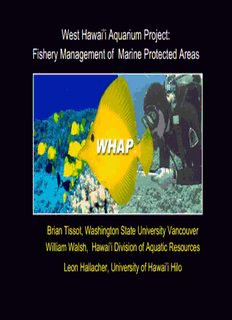
West Hawai’i Aquarium Project: Fishery Management of PDF
Preview West Hawai’i Aquarium Project: Fishery Management of
West Hawai’i Aquarium Project: Fishery Management of Marine Protected Areas Brian Tissot, Washington State University Vancouver William Walsh, Hawai’i Division of Aquatic Resources Leon Hallacher, University of Hawai’i Hilo WHAP was developed to meet the mandates of Act 306 (1998) Which created The West Hawai`i Regional Fisheries Management Area extending from Upolu Pt. to Ka Lae. And designated that > 30% of coastal waters be established as Fish Replenishment Areas (FRAs) where aquarium fish collecting is prohibited The FRAs shall be evaluated for effectiveness after 5 years in cooperation with the University of Hawai`i. Fish Replenishment Areas • Established by the legislature in 1998 • Closed Dec. 31, 1999: 1. North Kohala (4.8 k) 2. Puako (7.0) 3. Ka’upulehu (4.3) 4. Honokahau (3.4) 5. Kailua-Kona (7.8) 6. Red Hill (1.1) 7. Napo’opo’o (6.4) 8. Ho’okena (7.2) 9. Miloli’i (7.2) Created 49.1k 27.8% Pre-Existing 13.1 7.4% Total 62.2 35.2% WHAP Monitoring Program utilizes a powerful Before/After - Control/Impact Design (BACI) which permits multiple comparisons between open and protected areas and tracks areas through time 5k Lapakahi Control MLCD Observational Open design block Kamilo North Kohala FRA FRA WHAP Monitoring Program Study sites (23) - established March 1999 16 fish surveys (n= 1,472 transects) • Six baseline (pre-reserve closure) Ten post-reserve closure •Also survey major macro- invertebrates • Benthic video analysis Goal: evaluate effectiveness of FRAs as a management option • Do reserves increase fish stocks? • How do reserves differ? • What are important processes? • How does it affect the fishery? Prior to their establishment, the FRAs were heavily collected and several collected species at these sites were significantly less abundant relative to existing protected areas. This difference provides an estimate of the impact of aquarium collecting. Effects of Aquarium Collectors Pre-reserve baseline, 1999 20 n = 6 surveys * * * * * * * 0 e c n e -20 e g r ne af f hi d C -40 l o % r t n n o a C e -60 M- A R F -80 -100 * P < 0.05 F o u r-s p ot ABcFhille s tLa on ng g n o s e MB Fo o ris h IYd oelllo w TP aotntge r's A n gGelold rin g B FO r n ate MBulFti-s p ot B F Species Zebrasoma flavescens 30 Pre-closure Post-closure ) 2 m 25 0 0 1 Control / Pre-reserve # ( 20 y effects of t i s n collectors e FRA D 15 n a e Open M 10 9 9 9 9 9 9 0 0 0 0 0 1 1 1 1 9 9 9 9 9 9 0 0 0 0 0 0 0 0 0 M a r- M a y - J ul- S e p - O ct- D e c - F e b - A p r- J u n - A u g - N o v - F e b - A p r- J u n - A u g - Survey After first year of FRA establishment there was a significant decline in Aquarium fish species within both protected FRAs and open areas. Control-FRA-Impact Comparisons Top 10 Aquarium Species Pooled 16 Pre-reserve closure Post-reserve closure -6% * P < 0.05 ) 2 m 0 0 14 1 / # -10%* ( y t i s n 12 e D n -14%* a e M 10 Control FRA Impact Treatment Similar pattern in Non-Aquarium species Control-FRA-Impact Comparisons Non-Aquarium Species Pooled 16 Pre-reserve closure 0% Post-reserve closure * P < 0.05 ) 2 m 12 -14%* 0 0 1 / # ( y t i -11%* s n 8 e D n a e M 4 Control FRA Impact Treatment Poor recruitment of many reef fishes occurred during Year One survey period thus resulting in the failure of FRAs to increase fish populations. Recruitment during year two increased substantially. Density of New Recruits Zebrasoma flavescens 4 FRA establishment 2 0 ) 2 m 0 Ctenochaetus strigosus 0 6 1 / # ( y 3 t i s n e 0 D Chaetodon multicinctus 1 0 M ar-9 9 M a y-9 9 J ul-9 9 S e p-9 9 O ct-9 9 D e c-9 9 F e b-0 0 A pr-0 0 J u n-0 0 A u g-0 0 N o v-0 0 F e b-0 1 A pr-0 1 J u n-0 1 A u g-0 1 Survey Date
Description: